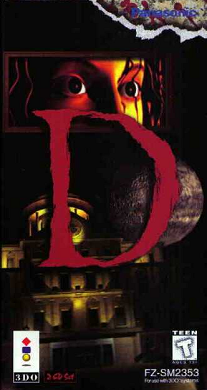D (video game)
| D | |
|---|---|

North American 3DO box art
|
|
| Developer(s) | WARP |
| Publisher(s) |
Panasonic Acclaim |
| Director(s) | Kenji Eno |
| Programmer(s) | Hirofumi Hayashida |
| Artist(s) | Shosaburou Tateishi |
| Writer(s) | Kenji Eno |
| Platform(s) | 3DO, Sega Saturn, PlayStation, MS-DOS |
| Release | |
| Genre(s) | Interactive movie, adventure |
| Mode(s) | Single-player |
| Review scores | |
|---|---|
| Publication | Score |
| CVG | 78% (SAT) |
| EGM | 32/40 (SAT) |
| Famitsu | 32/40 (SAT) 33/40 (PS) |
| GameFan | 262/300 (3DO) 275/300 (3DO) |
| Game Informer | 6/10 (SAT) |
| Game Revolution | C (SAT) |
| GamesMaster | 85% (SAT) |
| Play | 69% (PS) |
| Maximum |
|
| Next Generation |
|
| Sega Saturn Magazine | 83% (SAT) |
| Awards | |
|---|---|
| Publication | Award |
| GameFan's 4th Annual Megawards |
3DO Game of the Year, Best 3DO Graphic Adventure/FMV Game |
| GamePro Editors' Choice Awards 1995 | Third Best 3DO Game |
D is a psychological horror interactive movie and adventure game developed by WARP and directed by Kenji Eno. It is the first entry in the D series and was first published by Panasonic for the 3DO Interactive Multiplayer in 1995, later being ported to the Sega Saturn, PlayStation, and MS-DOS. The story follows Laura Harris as she goes to investigate a hospital after learning her father went on a mass murdering spree and barricaded himself inside. The hospital morphs into a castle upon her arrival, which she must explore to find her father. The player controls Laura through computer generated full motion video (FMV) sequences, and must complete the game within two hours without a save or pause function.
Development lasted about one year and was primarily done with Amiga 4000 computers to create the FMVs. It would be the first major release for the still-unknown Eno and WARP, and so Eno felt that if it were not successful he would quit from game development. He added scenes of violence and cannibalism to make the game more striking, however he believed the content would be too extreme for censors or publishers and feared the game would not be permitted for publishing. To ensure these scenes would not be censored, Eno submitted a "clean" version for publisher approval late, knowing they would require him to hand deliver the game to the manufacturer. On his way to the manufacturer, he switched the clean version with his master version containing the more disturbing content.
The game was a commercial and critical success in Japan, selling a million copies and receiving a special edition re-release. Critics in the West praised D's horror elements, story, graphics, and presentation. Reviewers of the 3DO version found it to be one of the best games on the platform. For the PlayStation release, Sony did not print enough copies to match pre-orders. Eno was very upset with this, and would later take revenge on Sony by releasing his later games exclusively on Sega platforms. D was followed by two sequels featuring the same "digital actress" named Laura although the stories are unrelated, Enemy Zero (1996) and D2 (1999). Modern retrospectives find D less appealing, but still commend it for its place in history as a unique blend of cinema and gaming and an early example of mature horror game design.
...
Wikipedia
